Analyzing New Media Credibility: Journalism and Reporting Standards
VerifiedAdded on 2023/06/12
|7
|1890
|115
Essay
AI Summary
This essay delves into the credibility of new media journalism, contrasting it with mainstream media practices. It highlights the reliance on citizen journalists, their amateurish news gathering methods, and the lack of adherence to media ethics and laws. The essay discusses issues such as source verification, fact-checking, and the potential for rumors to be disseminated as facts. It also contrasts the professional standards of mainstream journalists with the practices of new media journalists, who often prioritize speed and recognition over accuracy and brand reputation. The essay further explores how the absence of editorial oversight and the use of sensationalism can undermine the credibility of new media reports. Ultimately, it argues that the credibility of new media reports is often compromised by the lack of professional standards and rigorous verification processes.
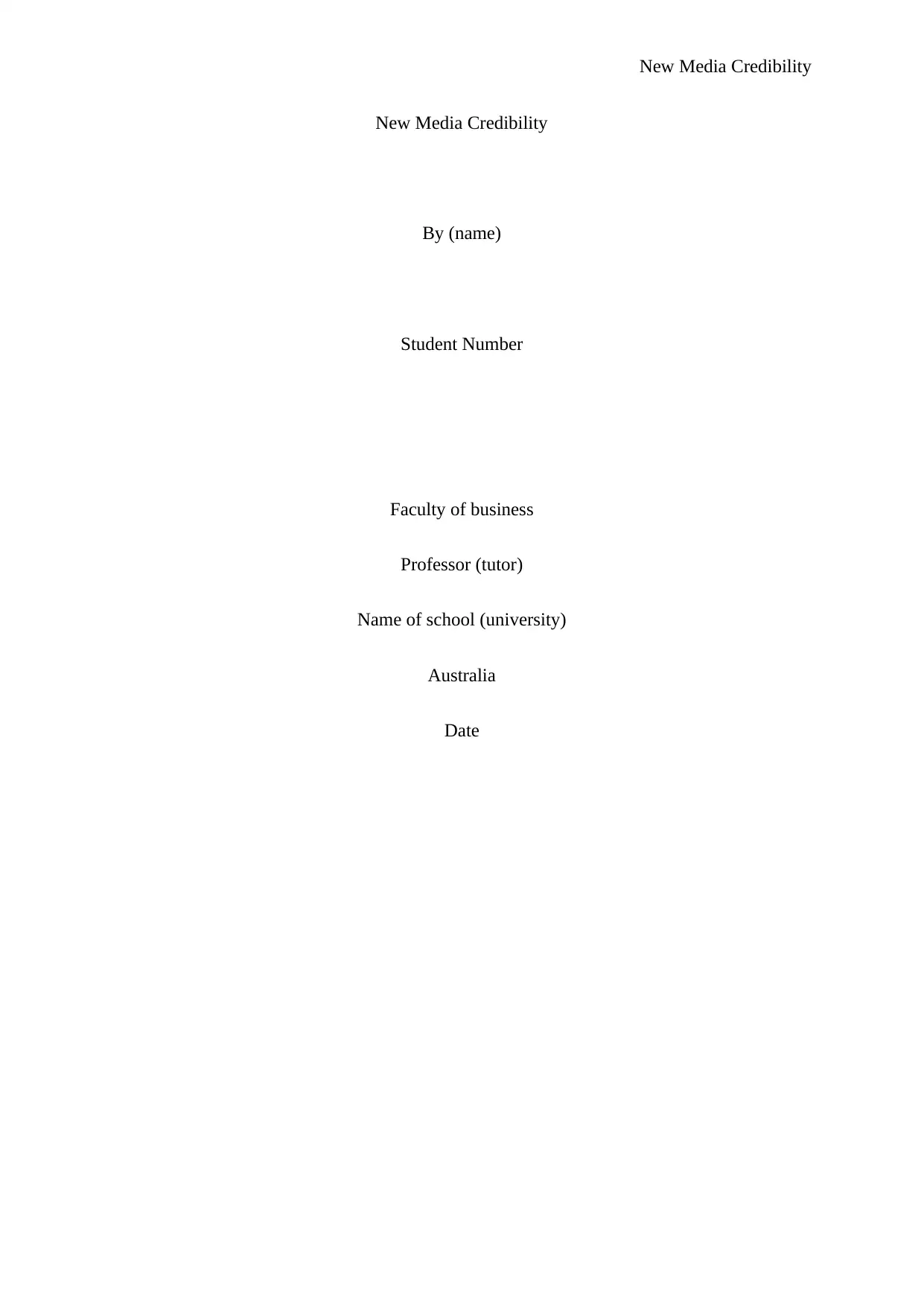
New Media Credibility
New Media Credibility
By (name)
Student Number
Faculty of business
Professor (tutor)
Name of school (university)
Australia
Date
New Media Credibility
By (name)
Student Number
Faculty of business
Professor (tutor)
Name of school (university)
Australia
Date
Paraphrase This Document
Need a fresh take? Get an instant paraphrase of this document with our AI Paraphraser
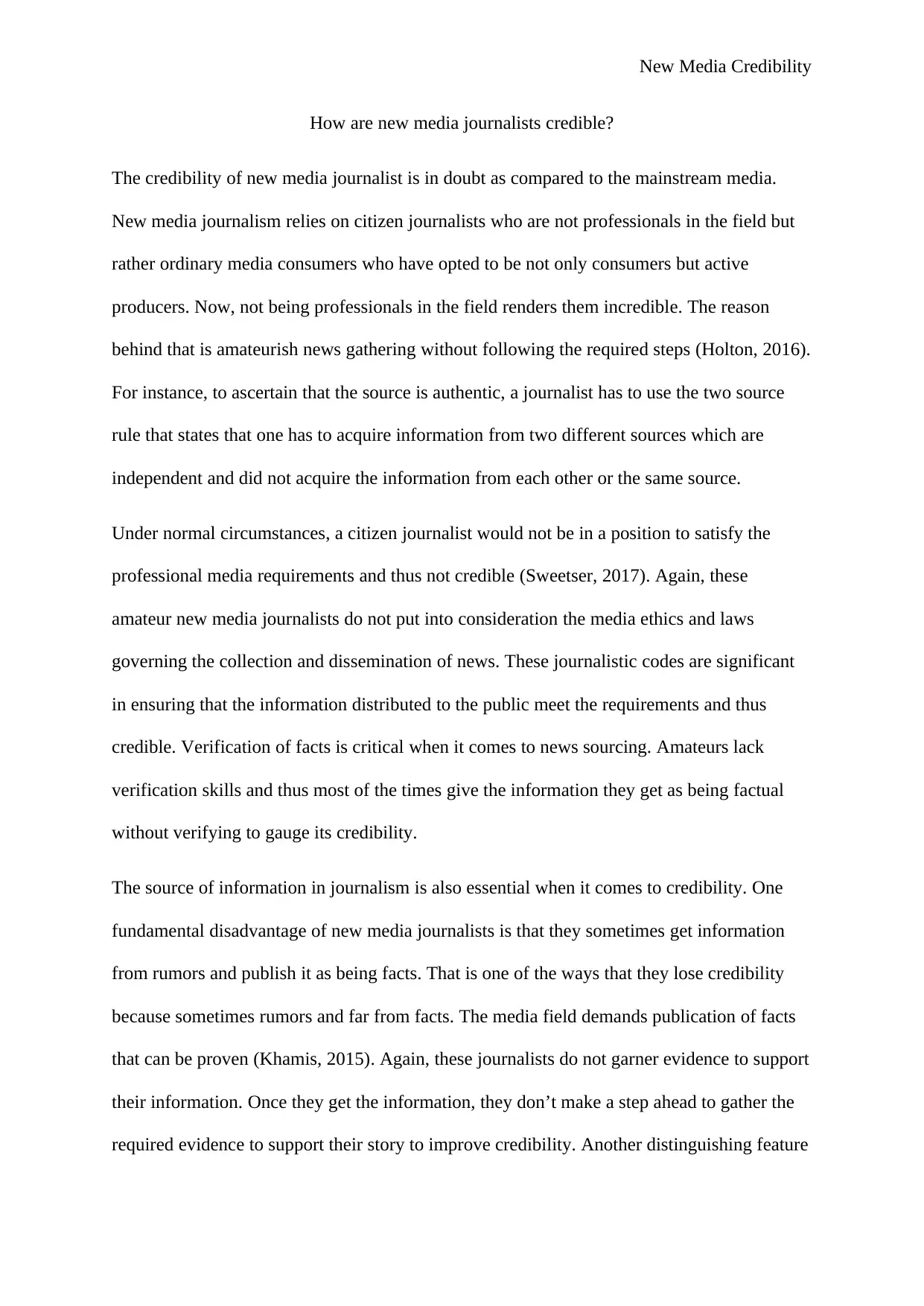
New Media Credibility
How are new media journalists credible?
The credibility of new media journalist is in doubt as compared to the mainstream media.
New media journalism relies on citizen journalists who are not professionals in the field but
rather ordinary media consumers who have opted to be not only consumers but active
producers. Now, not being professionals in the field renders them incredible. The reason
behind that is amateurish news gathering without following the required steps (Holton, 2016).
For instance, to ascertain that the source is authentic, a journalist has to use the two source
rule that states that one has to acquire information from two different sources which are
independent and did not acquire the information from each other or the same source.
Under normal circumstances, a citizen journalist would not be in a position to satisfy the
professional media requirements and thus not credible (Sweetser, 2017). Again, these
amateur new media journalists do not put into consideration the media ethics and laws
governing the collection and dissemination of news. These journalistic codes are significant
in ensuring that the information distributed to the public meet the requirements and thus
credible. Verification of facts is critical when it comes to news sourcing. Amateurs lack
verification skills and thus most of the times give the information they get as being factual
without verifying to gauge its credibility.
The source of information in journalism is also essential when it comes to credibility. One
fundamental disadvantage of new media journalists is that they sometimes get information
from rumors and publish it as being facts. That is one of the ways that they lose credibility
because sometimes rumors and far from facts. The media field demands publication of facts
that can be proven (Khamis, 2015). Again, these journalists do not garner evidence to support
their information. Once they get the information, they don’t make a step ahead to gather the
required evidence to support their story to improve credibility. Another distinguishing feature
How are new media journalists credible?
The credibility of new media journalist is in doubt as compared to the mainstream media.
New media journalism relies on citizen journalists who are not professionals in the field but
rather ordinary media consumers who have opted to be not only consumers but active
producers. Now, not being professionals in the field renders them incredible. The reason
behind that is amateurish news gathering without following the required steps (Holton, 2016).
For instance, to ascertain that the source is authentic, a journalist has to use the two source
rule that states that one has to acquire information from two different sources which are
independent and did not acquire the information from each other or the same source.
Under normal circumstances, a citizen journalist would not be in a position to satisfy the
professional media requirements and thus not credible (Sweetser, 2017). Again, these
amateur new media journalists do not put into consideration the media ethics and laws
governing the collection and dissemination of news. These journalistic codes are significant
in ensuring that the information distributed to the public meet the requirements and thus
credible. Verification of facts is critical when it comes to news sourcing. Amateurs lack
verification skills and thus most of the times give the information they get as being factual
without verifying to gauge its credibility.
The source of information in journalism is also essential when it comes to credibility. One
fundamental disadvantage of new media journalists is that they sometimes get information
from rumors and publish it as being facts. That is one of the ways that they lose credibility
because sometimes rumors and far from facts. The media field demands publication of facts
that can be proven (Khamis, 2015). Again, these journalists do not garner evidence to support
their information. Once they get the information, they don’t make a step ahead to gather the
required evidence to support their story to improve credibility. Another distinguishing feature
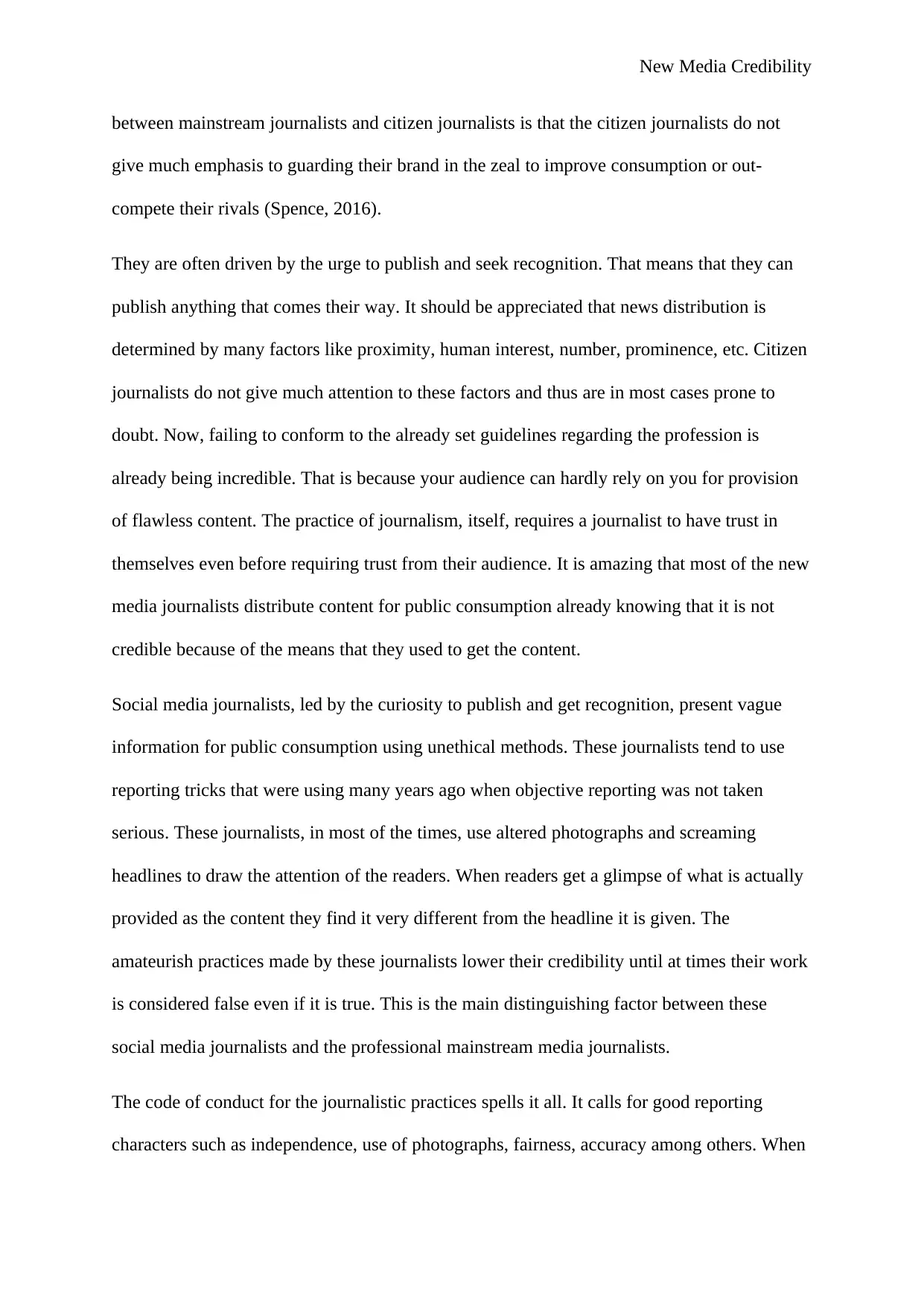
New Media Credibility
between mainstream journalists and citizen journalists is that the citizen journalists do not
give much emphasis to guarding their brand in the zeal to improve consumption or out-
compete their rivals (Spence, 2016).
They are often driven by the urge to publish and seek recognition. That means that they can
publish anything that comes their way. It should be appreciated that news distribution is
determined by many factors like proximity, human interest, number, prominence, etc. Citizen
journalists do not give much attention to these factors and thus are in most cases prone to
doubt. Now, failing to conform to the already set guidelines regarding the profession is
already being incredible. That is because your audience can hardly rely on you for provision
of flawless content. The practice of journalism, itself, requires a journalist to have trust in
themselves even before requiring trust from their audience. It is amazing that most of the new
media journalists distribute content for public consumption already knowing that it is not
credible because of the means that they used to get the content.
Social media journalists, led by the curiosity to publish and get recognition, present vague
information for public consumption using unethical methods. These journalists tend to use
reporting tricks that were using many years ago when objective reporting was not taken
serious. These journalists, in most of the times, use altered photographs and screaming
headlines to draw the attention of the readers. When readers get a glimpse of what is actually
provided as the content they find it very different from the headline it is given. The
amateurish practices made by these journalists lower their credibility until at times their work
is considered false even if it is true. This is the main distinguishing factor between these
social media journalists and the professional mainstream media journalists.
The code of conduct for the journalistic practices spells it all. It calls for good reporting
characters such as independence, use of photographs, fairness, accuracy among others. When
between mainstream journalists and citizen journalists is that the citizen journalists do not
give much emphasis to guarding their brand in the zeal to improve consumption or out-
compete their rivals (Spence, 2016).
They are often driven by the urge to publish and seek recognition. That means that they can
publish anything that comes their way. It should be appreciated that news distribution is
determined by many factors like proximity, human interest, number, prominence, etc. Citizen
journalists do not give much attention to these factors and thus are in most cases prone to
doubt. Now, failing to conform to the already set guidelines regarding the profession is
already being incredible. That is because your audience can hardly rely on you for provision
of flawless content. The practice of journalism, itself, requires a journalist to have trust in
themselves even before requiring trust from their audience. It is amazing that most of the new
media journalists distribute content for public consumption already knowing that it is not
credible because of the means that they used to get the content.
Social media journalists, led by the curiosity to publish and get recognition, present vague
information for public consumption using unethical methods. These journalists tend to use
reporting tricks that were using many years ago when objective reporting was not taken
serious. These journalists, in most of the times, use altered photographs and screaming
headlines to draw the attention of the readers. When readers get a glimpse of what is actually
provided as the content they find it very different from the headline it is given. The
amateurish practices made by these journalists lower their credibility until at times their work
is considered false even if it is true. This is the main distinguishing factor between these
social media journalists and the professional mainstream media journalists.
The code of conduct for the journalistic practices spells it all. It calls for good reporting
characters such as independence, use of photographs, fairness, accuracy among others. When
⊘ This is a preview!⊘
Do you want full access?
Subscribe today to unlock all pages.

Trusted by 1+ million students worldwide
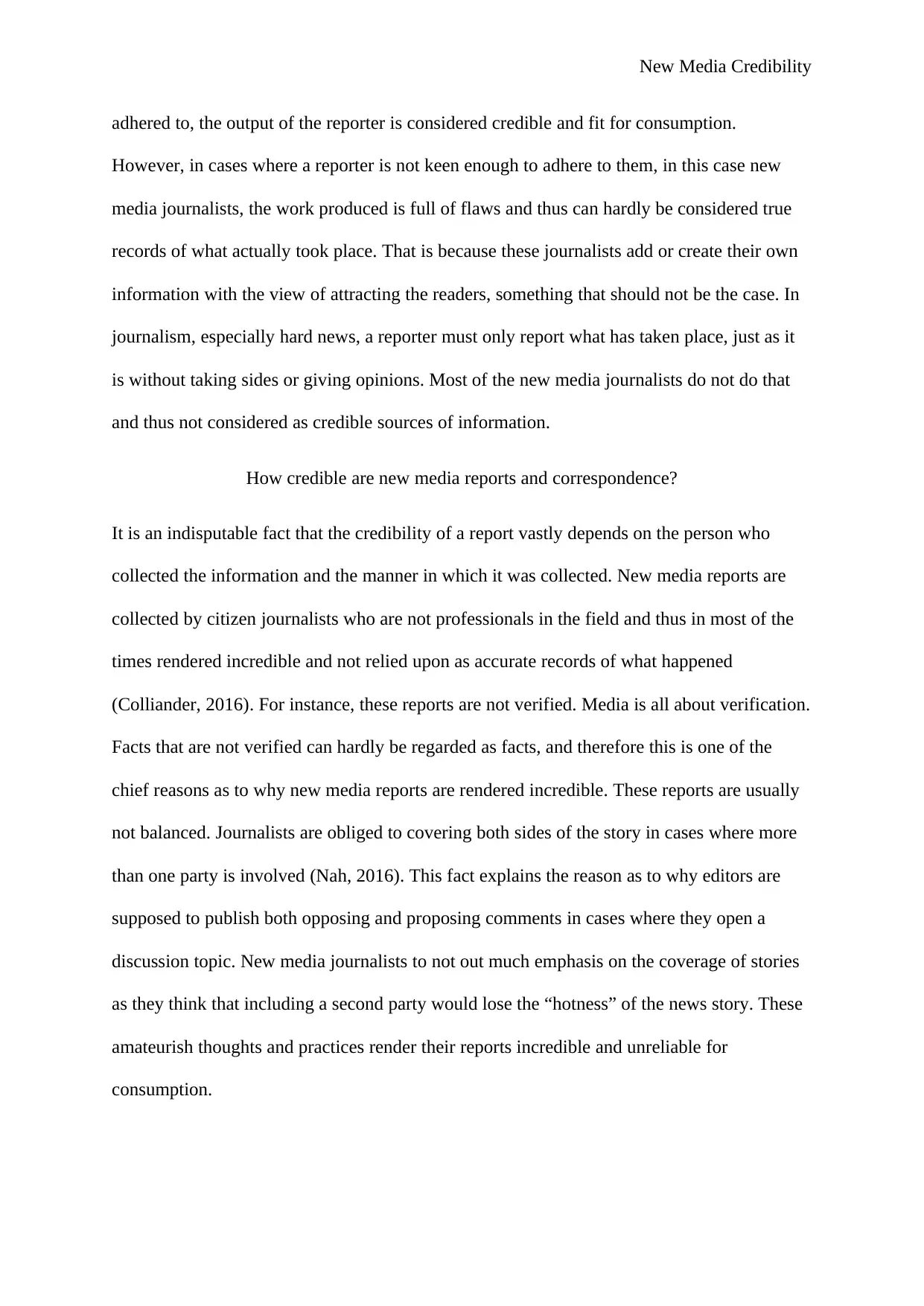
New Media Credibility
adhered to, the output of the reporter is considered credible and fit for consumption.
However, in cases where a reporter is not keen enough to adhere to them, in this case new
media journalists, the work produced is full of flaws and thus can hardly be considered true
records of what actually took place. That is because these journalists add or create their own
information with the view of attracting the readers, something that should not be the case. In
journalism, especially hard news, a reporter must only report what has taken place, just as it
is without taking sides or giving opinions. Most of the new media journalists do not do that
and thus not considered as credible sources of information.
How credible are new media reports and correspondence?
It is an indisputable fact that the credibility of a report vastly depends on the person who
collected the information and the manner in which it was collected. New media reports are
collected by citizen journalists who are not professionals in the field and thus in most of the
times rendered incredible and not relied upon as accurate records of what happened
(Colliander, 2016). For instance, these reports are not verified. Media is all about verification.
Facts that are not verified can hardly be regarded as facts, and therefore this is one of the
chief reasons as to why new media reports are rendered incredible. These reports are usually
not balanced. Journalists are obliged to covering both sides of the story in cases where more
than one party is involved (Nah, 2016). This fact explains the reason as to why editors are
supposed to publish both opposing and proposing comments in cases where they open a
discussion topic. New media journalists to not out much emphasis on the coverage of stories
as they think that including a second party would lose the “hotness” of the news story. These
amateurish thoughts and practices render their reports incredible and unreliable for
consumption.
adhered to, the output of the reporter is considered credible and fit for consumption.
However, in cases where a reporter is not keen enough to adhere to them, in this case new
media journalists, the work produced is full of flaws and thus can hardly be considered true
records of what actually took place. That is because these journalists add or create their own
information with the view of attracting the readers, something that should not be the case. In
journalism, especially hard news, a reporter must only report what has taken place, just as it
is without taking sides or giving opinions. Most of the new media journalists do not do that
and thus not considered as credible sources of information.
How credible are new media reports and correspondence?
It is an indisputable fact that the credibility of a report vastly depends on the person who
collected the information and the manner in which it was collected. New media reports are
collected by citizen journalists who are not professionals in the field and thus in most of the
times rendered incredible and not relied upon as accurate records of what happened
(Colliander, 2016). For instance, these reports are not verified. Media is all about verification.
Facts that are not verified can hardly be regarded as facts, and therefore this is one of the
chief reasons as to why new media reports are rendered incredible. These reports are usually
not balanced. Journalists are obliged to covering both sides of the story in cases where more
than one party is involved (Nah, 2016). This fact explains the reason as to why editors are
supposed to publish both opposing and proposing comments in cases where they open a
discussion topic. New media journalists to not out much emphasis on the coverage of stories
as they think that including a second party would lose the “hotness” of the news story. These
amateurish thoughts and practices render their reports incredible and unreliable for
consumption.
Paraphrase This Document
Need a fresh take? Get an instant paraphrase of this document with our AI Paraphraser
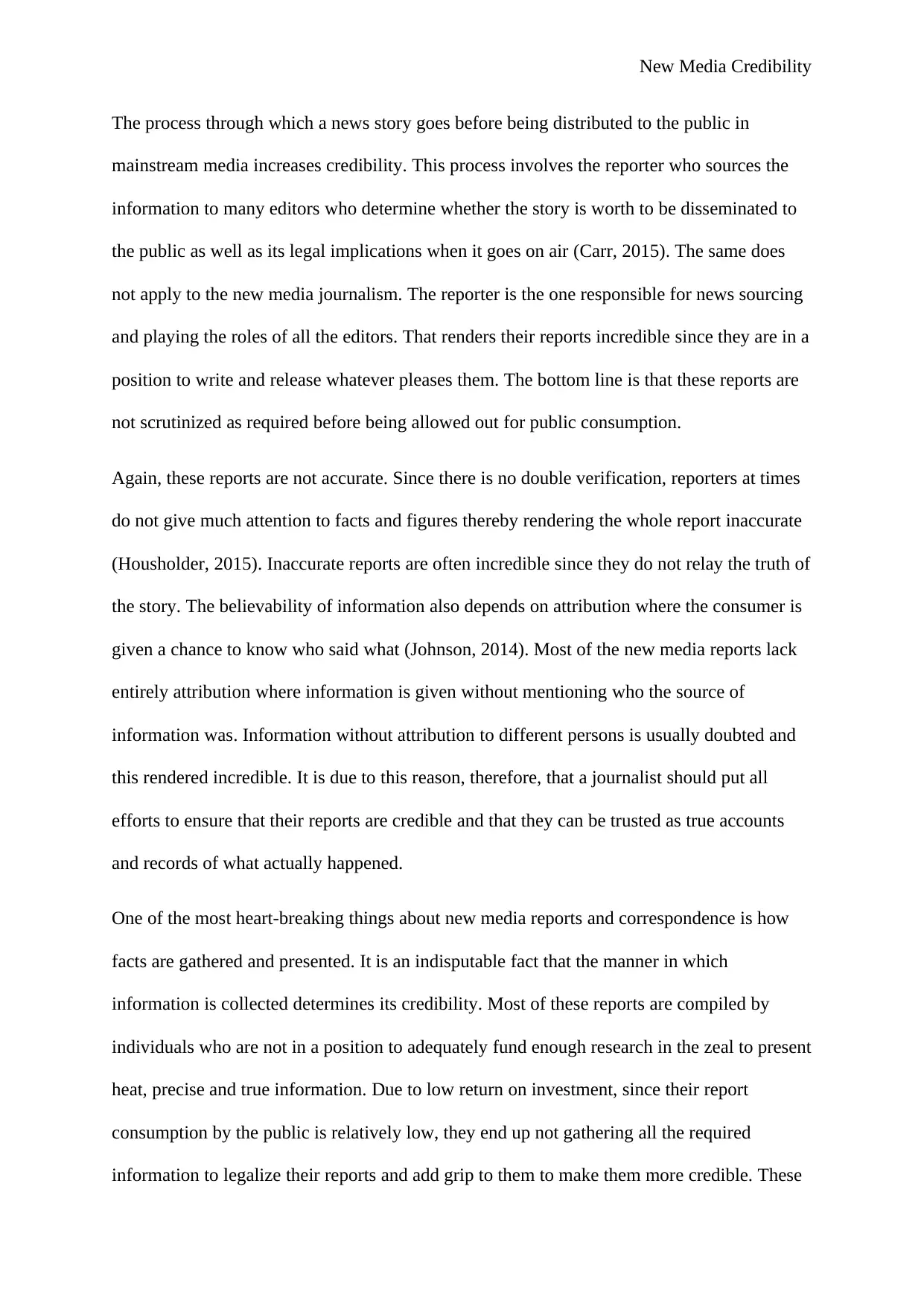
New Media Credibility
The process through which a news story goes before being distributed to the public in
mainstream media increases credibility. This process involves the reporter who sources the
information to many editors who determine whether the story is worth to be disseminated to
the public as well as its legal implications when it goes on air (Carr, 2015). The same does
not apply to the new media journalism. The reporter is the one responsible for news sourcing
and playing the roles of all the editors. That renders their reports incredible since they are in a
position to write and release whatever pleases them. The bottom line is that these reports are
not scrutinized as required before being allowed out for public consumption.
Again, these reports are not accurate. Since there is no double verification, reporters at times
do not give much attention to facts and figures thereby rendering the whole report inaccurate
(Housholder, 2015). Inaccurate reports are often incredible since they do not relay the truth of
the story. The believability of information also depends on attribution where the consumer is
given a chance to know who said what (Johnson, 2014). Most of the new media reports lack
entirely attribution where information is given without mentioning who the source of
information was. Information without attribution to different persons is usually doubted and
this rendered incredible. It is due to this reason, therefore, that a journalist should put all
efforts to ensure that their reports are credible and that they can be trusted as true accounts
and records of what actually happened.
One of the most heart-breaking things about new media reports and correspondence is how
facts are gathered and presented. It is an indisputable fact that the manner in which
information is collected determines its credibility. Most of these reports are compiled by
individuals who are not in a position to adequately fund enough research in the zeal to present
heat, precise and true information. Due to low return on investment, since their report
consumption by the public is relatively low, they end up not gathering all the required
information to legalize their reports and add grip to them to make them more credible. These
The process through which a news story goes before being distributed to the public in
mainstream media increases credibility. This process involves the reporter who sources the
information to many editors who determine whether the story is worth to be disseminated to
the public as well as its legal implications when it goes on air (Carr, 2015). The same does
not apply to the new media journalism. The reporter is the one responsible for news sourcing
and playing the roles of all the editors. That renders their reports incredible since they are in a
position to write and release whatever pleases them. The bottom line is that these reports are
not scrutinized as required before being allowed out for public consumption.
Again, these reports are not accurate. Since there is no double verification, reporters at times
do not give much attention to facts and figures thereby rendering the whole report inaccurate
(Housholder, 2015). Inaccurate reports are often incredible since they do not relay the truth of
the story. The believability of information also depends on attribution where the consumer is
given a chance to know who said what (Johnson, 2014). Most of the new media reports lack
entirely attribution where information is given without mentioning who the source of
information was. Information without attribution to different persons is usually doubted and
this rendered incredible. It is due to this reason, therefore, that a journalist should put all
efforts to ensure that their reports are credible and that they can be trusted as true accounts
and records of what actually happened.
One of the most heart-breaking things about new media reports and correspondence is how
facts are gathered and presented. It is an indisputable fact that the manner in which
information is collected determines its credibility. Most of these reports are compiled by
individuals who are not in a position to adequately fund enough research in the zeal to present
heat, precise and true information. Due to low return on investment, since their report
consumption by the public is relatively low, they end up not gathering all the required
information to legalize their reports and add grip to them to make them more credible. These
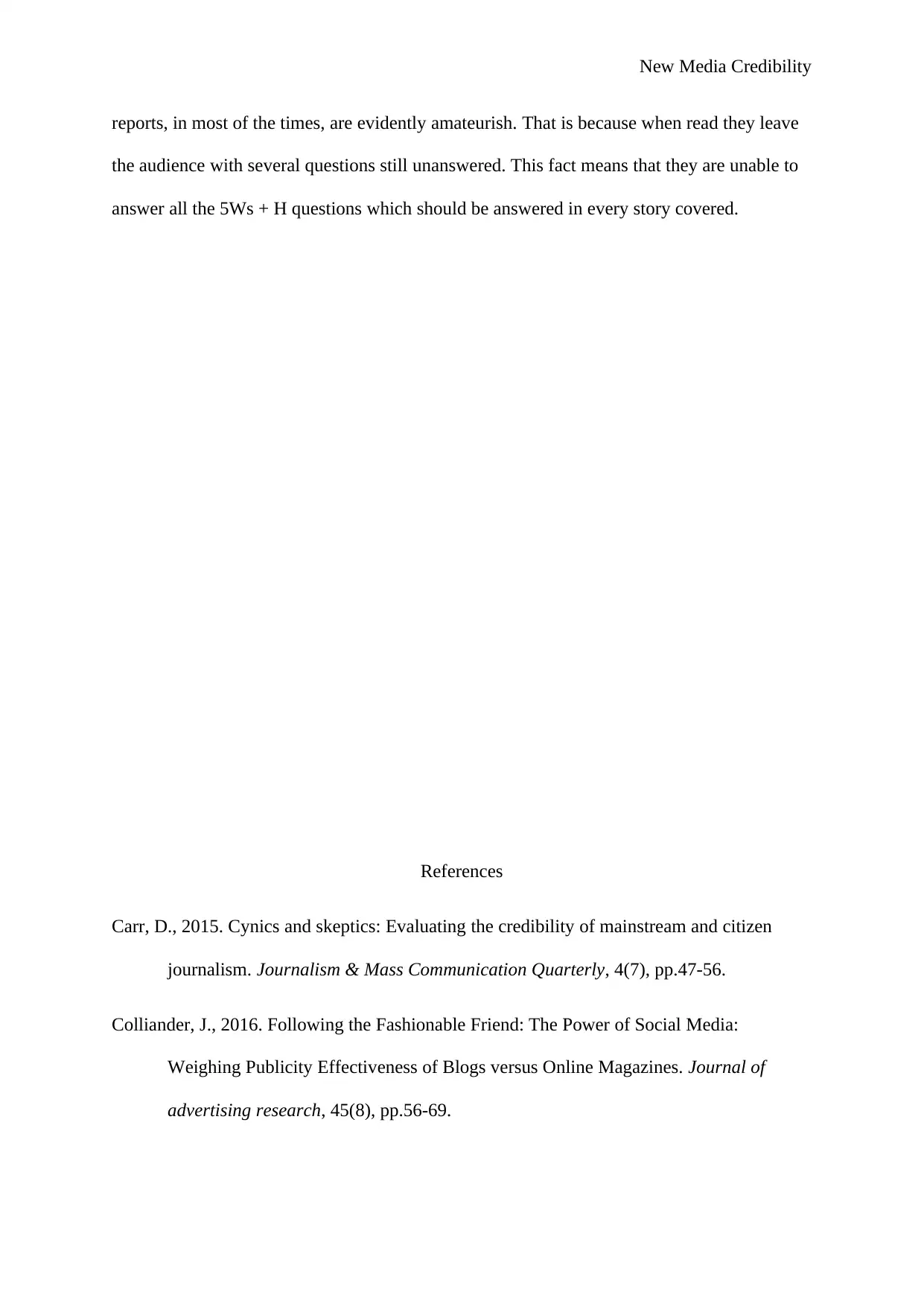
New Media Credibility
reports, in most of the times, are evidently amateurish. That is because when read they leave
the audience with several questions still unanswered. This fact means that they are unable to
answer all the 5Ws + H questions which should be answered in every story covered.
References
Carr, D., 2015. Cynics and skeptics: Evaluating the credibility of mainstream and citizen
journalism. Journalism & Mass Communication Quarterly, 4(7), pp.47-56.
Colliander, J., 2016. Following the Fashionable Friend: The Power of Social Media:
Weighing Publicity Effectiveness of Blogs versus Online Magazines. Journal of
advertising research, 45(8), pp.56-69.
reports, in most of the times, are evidently amateurish. That is because when read they leave
the audience with several questions still unanswered. This fact means that they are unable to
answer all the 5Ws + H questions which should be answered in every story covered.
References
Carr, D., 2015. Cynics and skeptics: Evaluating the credibility of mainstream and citizen
journalism. Journalism & Mass Communication Quarterly, 4(7), pp.47-56.
Colliander, J., 2016. Following the Fashionable Friend: The Power of Social Media:
Weighing Publicity Effectiveness of Blogs versus Online Magazines. Journal of
advertising research, 45(8), pp.56-69.
⊘ This is a preview!⊘
Do you want full access?
Subscribe today to unlock all pages.

Trusted by 1+ million students worldwide
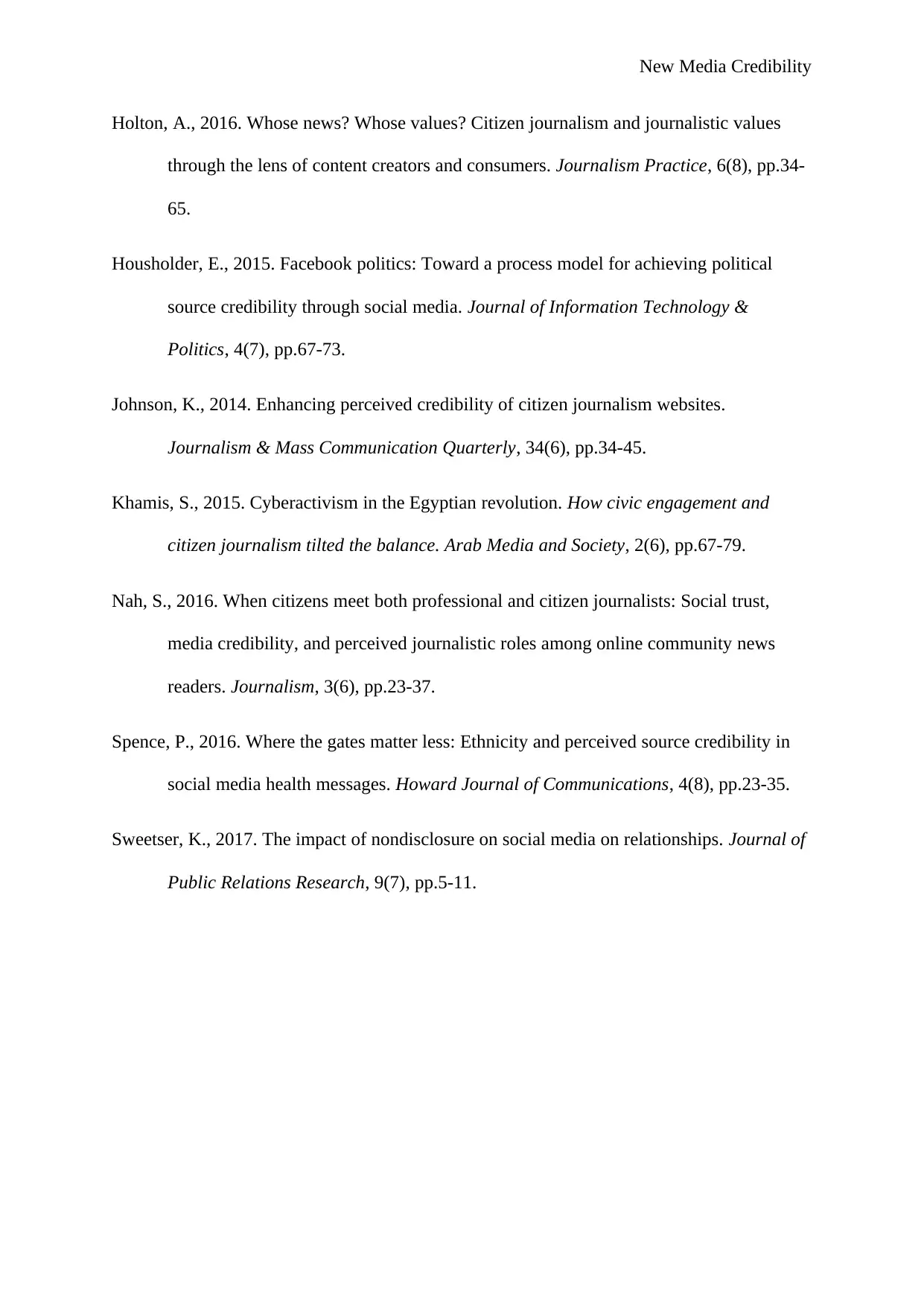
New Media Credibility
Holton, A., 2016. Whose news? Whose values? Citizen journalism and journalistic values
through the lens of content creators and consumers. Journalism Practice, 6(8), pp.34-
65.
Housholder, E., 2015. Facebook politics: Toward a process model for achieving political
source credibility through social media. Journal of Information Technology &
Politics, 4(7), pp.67-73.
Johnson, K., 2014. Enhancing perceived credibility of citizen journalism websites.
Journalism & Mass Communication Quarterly, 34(6), pp.34-45.
Khamis, S., 2015. Cyberactivism in the Egyptian revolution. How civic engagement and
citizen journalism tilted the balance. Arab Media and Society, 2(6), pp.67-79.
Nah, S., 2016. When citizens meet both professional and citizen journalists: Social trust,
media credibility, and perceived journalistic roles among online community news
readers. Journalism, 3(6), pp.23-37.
Spence, P., 2016. Where the gates matter less: Ethnicity and perceived source credibility in
social media health messages. Howard Journal of Communications, 4(8), pp.23-35.
Sweetser, K., 2017. The impact of nondisclosure on social media on relationships. Journal of
Public Relations Research, 9(7), pp.5-11.
Holton, A., 2016. Whose news? Whose values? Citizen journalism and journalistic values
through the lens of content creators and consumers. Journalism Practice, 6(8), pp.34-
65.
Housholder, E., 2015. Facebook politics: Toward a process model for achieving political
source credibility through social media. Journal of Information Technology &
Politics, 4(7), pp.67-73.
Johnson, K., 2014. Enhancing perceived credibility of citizen journalism websites.
Journalism & Mass Communication Quarterly, 34(6), pp.34-45.
Khamis, S., 2015. Cyberactivism in the Egyptian revolution. How civic engagement and
citizen journalism tilted the balance. Arab Media and Society, 2(6), pp.67-79.
Nah, S., 2016. When citizens meet both professional and citizen journalists: Social trust,
media credibility, and perceived journalistic roles among online community news
readers. Journalism, 3(6), pp.23-37.
Spence, P., 2016. Where the gates matter less: Ethnicity and perceived source credibility in
social media health messages. Howard Journal of Communications, 4(8), pp.23-35.
Sweetser, K., 2017. The impact of nondisclosure on social media on relationships. Journal of
Public Relations Research, 9(7), pp.5-11.
1 out of 7
Related Documents
Your All-in-One AI-Powered Toolkit for Academic Success.
+13062052269
info@desklib.com
Available 24*7 on WhatsApp / Email
![[object Object]](/_next/static/media/star-bottom.7253800d.svg)
Unlock your academic potential
Copyright © 2020–2025 A2Z Services. All Rights Reserved. Developed and managed by ZUCOL.





